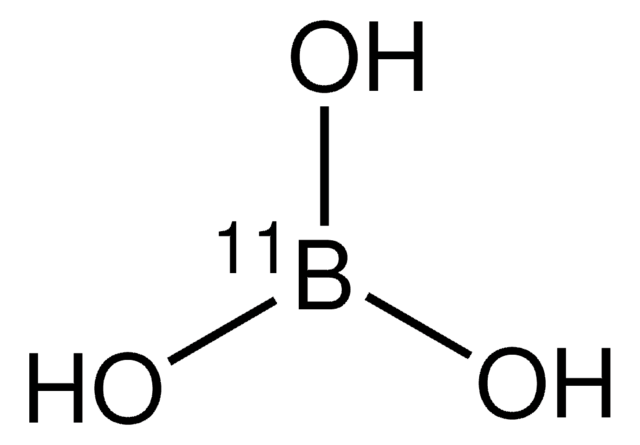Kluczowe dokumenty
202878
Boric acid
99.999% trace metals basis
Synonim(y):
kwas ortoborowy
About This Item
Polecane produkty
ciśnienie pary
2.6 mmHg ( 20 °C)
Próba
99.999% trace metals basis
Formularz
crystalline powder
mp
160 °C (dec.) (lit.)
rozpuszczalność
water: 49.2 g/L at 20 °C
gęstość
1.49 g/cm3 at 23 °C
ciąg SMILES
OB(O)O
InChI
1S/BH3O3/c2-1(3)4/h2-4H
Klucz InChI
KGBXLFKZBHKPEV-UHFFFAOYSA-N
Szukasz podobnych produktów? Odwiedź Przewodnik dotyczący porównywania produktów
Powiązane kategorie
Opis ogólny
Zastosowanie
Boric acid finds uses in several areas; such as
- In glass fibres, to enhance its resistance and color
- In glazing ceramic wares
- As a condensing agent, chemical intermediate and as a precursor for preparation of borates and other boron based compounds
- As a water coolant in nuclear reactors
- In electrolytic condensers and capacitors 1
Opakowanie
Hasło ostrzegawcze
Danger
Zwroty wskazujące rodzaj zagrożenia
Zwroty wskazujące środki ostrożności
Klasyfikacja zagrożeń
Repr. 1B
Kod klasy składowania
6.1C - Combustible acute toxic Cat.3 / toxic compounds or compounds which causing chronic effects
Klasa zagrożenia wodnego (WGK)
WGK 1
Temperatura zapłonu (°F)
Not applicable
Temperatura zapłonu (°C)
Not applicable
Środki ochrony indywidualnej
Eyeshields, Gloves, type P3 (EN 143) respirator cartridges
Wykazy regulacyjne
Wykazy regulacyjne dotyczą głównie produktów chemicznych. Można w nich podawać ograniczoną liczbę informacji na temat produktów niechemicznych. Brak wpisu oznacza, że żaden ze składników nie znajduje się w wykazie. Użytkownik odpowiada za zagwarantowanie bezpiecznego i zgodnego z prawem stosowania produktu.
EU REACH SVHC Candidate List
EU REACH Annex XVII (Restriction List)
Wybierz jedną z najnowszych wersji:
Certyfikaty analizy (CoA)
Nie widzisz odpowiedniej wersji?
Jeśli potrzebujesz konkretnej wersji, możesz wyszukać konkretny certyfikat według numeru partii lub serii.
Masz już ten produkt?
Dokumenty związane z niedawno zakupionymi produktami zostały zamieszczone w Bibliotece dokumentów.
Klienci oglądali również te produkty
Produkty
Carbon Molecular sieves (CMS) are a versatile range of adsorbents that can be tailored for specific applications. Supelco® scientists have been synthesizing synthetic CMS carbons for several decades, starting from tailoring of the starting polymers/copolymers, to modifying the final properties of the subsequent CMS carbon.
Syntetyczne węgle CMS oferują adsorbenty dostosowane do konkretnych zastosowań.
Nasz zespół naukowców ma doświadczenie we wszystkich obszarach badań, w tym w naukach przyrodniczych, materiałoznawstwie, syntezie chemicznej, chromatografii, analityce i wielu innych dziedzinach.
Skontaktuj się z zespołem ds. pomocy technicznej



